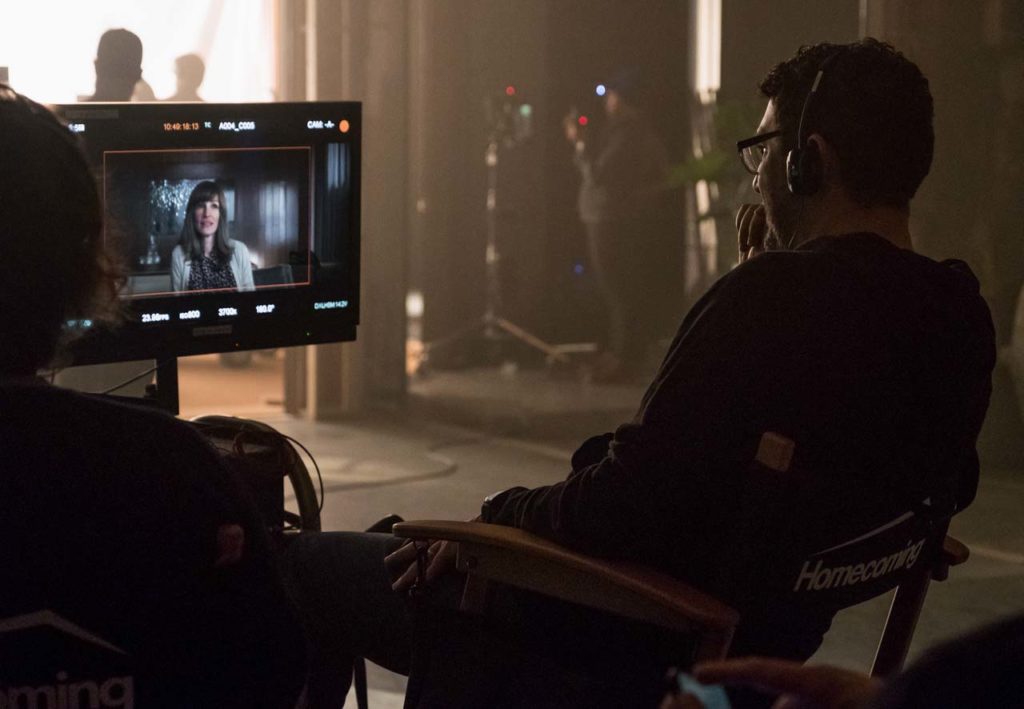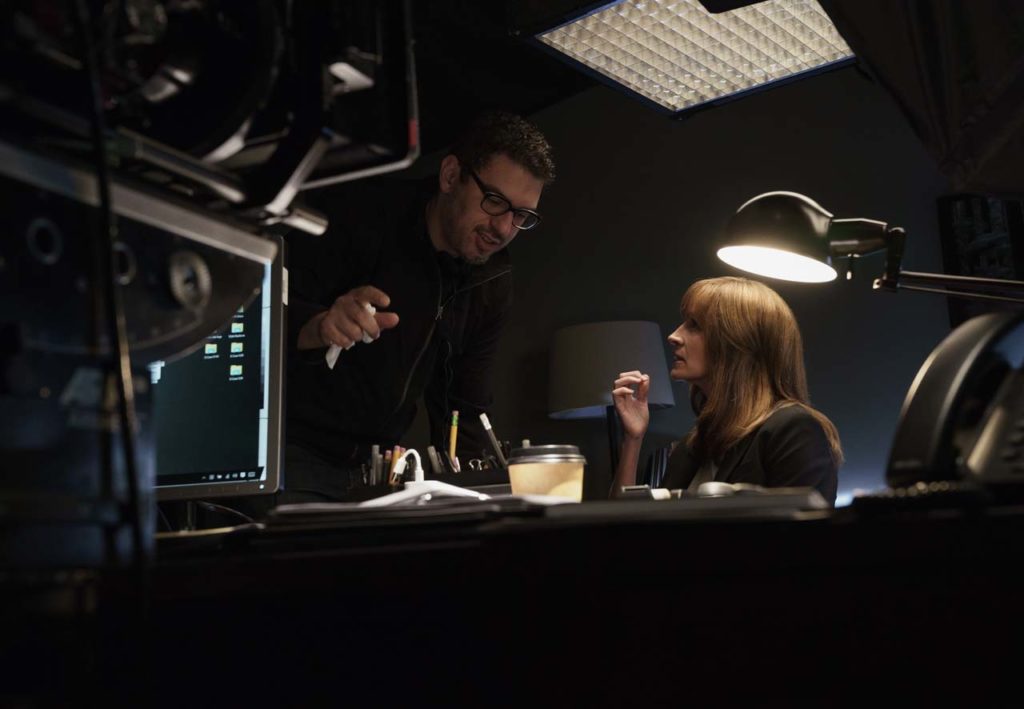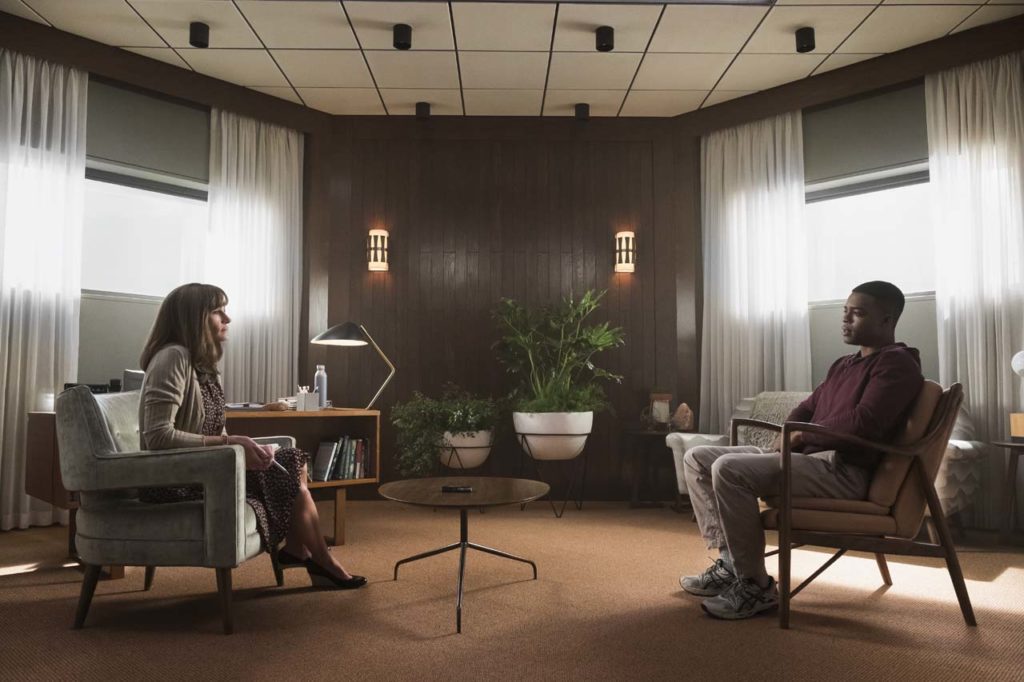IN HER FIRST LEAD TV ROLE, THE OSCAR WINNER TAKES ON AN AMAZON STUDIOS AND UNIVERSAL CABLE PRODUCTIONS ADAPTATION OF AN ACCLAIMED PODCAST SET IN A WARWOUNDED U.S. IN SEARCH OF FORGETTING
BY MATT SCANLON
Though Julia Roberts has racked up more than 30 lms since her 1988 breakout role in Mystic Pizza, she has taken, until this year, nary a single TV starring turn. ere have been walk ons, small parts, and cameos in shows like Friends, Law & Order, and Murphy Brown, but long term productions for the 51 year old Oscar winner have been exclusively cinematic. It took a $1 trillion company and a unique script to change her mind. From Sam Esmail, the creator of USA Network’s Mr. Robot, and based on the scripted podcast, Homecoming, Universal Cable Productions lured her with a genre bending psychological thriller, which began streaming on Amazon Prime Video in early November.

Homecoming features Roberts as Heidi Bergman, a caseworker at Homecoming Transitional Support T Center, a facility that treats combat soldiers returning home, in part by manipulating memories to better streamline them into society. There, she counsels a young vet, Walter Cruz, played by Stephan James (from the films Selma and Race). Emmy winner Bobby Cannavale (Boardwalk Empire) plays Bergman’s nerve wracking off site supervisor, Colin, with Alex Karpovsky (Girls) as the facility’s life skills coach, Craig. Dermot Mulroney plays Anthony, Bergman’s boyfriend.
Over the course of the 10 part series, this narrative alternates with another that takes place four years later, one that finds Bergman in a new life as a small town waitress living with her mother (Oscar winner Sissy Spacek). When a Department of Defense auditor questions her about her departure from the Homecoming facility, Heidi begins to question her own reality.
All of Homecoming’s half hour episodes were directed by Esmail, and written by the original podcast creators Eli Horowitz and Micah Bloomberg, along with David Weiner, Cami Delavigne, Shannon Houston, and Eric Simonson. In creating the unsettling visual style and tone, the director reunited his crew from the Emmy and Golden Globe Award winning Mr. Robot, which recently aired its third season. The series was the first project shot on Universal Studios’ new production facilities outside of Los Angeles.

Esmail explained, in an Amazon interview, that he wanted to avoid formula in translating the podcast to a visual medium. “I did not want to make it ‘cinematic,’” he said. “There’s a tendency when you adapt something for the big screen whether from a book or a podcast that it has to be ‘bigger.’ I wanted it to stay as intimate and small as it was in the original.” Asked how he would make often dialog heavy scenes visually arresting, he explained that he took cues from two legends: Alfred Hitchcock and Brian DePalma. “I wanted this to be a throwback to character based thrillers. It’s baroque and pastiche, without actually throwing it back into the past.”
In considering the role of Heidi Bergman, and despite it being her first ever lead in a TV series, this was a relatively easy “yes,” according to Roberts.
“I was really taken with the podcast,” she said in a studio interview. “The characters were terrific. Catherine Keener is a friend of mine; she played Heidi in the podcast, and she was fantastic. I was listening to it with TV in mind. The audio, the sound production, the fish tank bubbles… it was all so visual. [Writers] Micah and Eli know this material inside and out.”

When asked if the transition from big to small screen involved any unique process tweaks or generated any particular concerns, Roberts said that Esmail’s track record of executing complex material for TV made the transition nearly worry free.
“He’s is an incredible intellect and has such a very specific vision,” she said. “I come from film, where there’s just one captain throughout. And I know from friends and family who work in TV that there’s often a changing of the guard in every episode, which I’m unaccustomed to.” Homecoming was “surgical” in its complexity, observed Roberts including different time periods and variety of characters and so required one voice behind it the whole time. “I said from the beginning that I really wanted one person to direct all the episodes. And if that person wasn’t Sam, then I probably wouldn’t do it.”
Co-star Cannavale added that he considered the script to be of particular, and amplifying, relevance.
“We’re in the midst of a time in America in which we don’t really know what’s going on. There is a fomenting of an atmosphere of suspicion. What is America’s role right now? The idea of the Homecoming initiative that it’s possible that we could re deploy veterans after we’ve erased their memories suddenly isn’t that outlandish an idea.”
For the massive set, two stages were joined into one 36,000 square foot production space with a 51 foot grid height.

“They built [the set] so that we could do these incredible camera maneuvers,” said Roberts. “I think there were days when we’ve done 11 pages of dialogue in one camera move up and down hallways, down stairs, through huge conference rooms and cafeterias it’s pretty amazing. The show could be renamed No Easy Days, because there were none! But my collaboration with Sam has been so joyful. We’re two peas in a pod. He’s very specific and clear in his direction. It’s been relatively effortless.”
